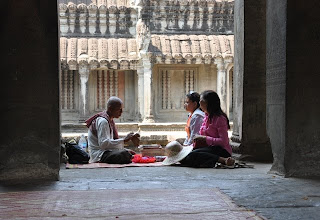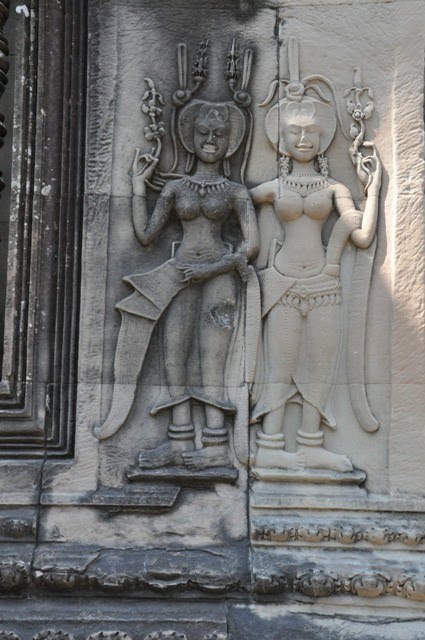After leaving Bayon we headed for our car via some interesting terraces, the Elephant Terrace and the Terrace of the Leper King which lie past yet another ruined temple shaped like a pyramid.
The terraces are raised platforms where the royal family must have looked out over the ceremonial grounds under wooden pavilions and umbrellas; the elephant terrace has large, almost life-sized elephants in bas-relief over the face of the wall as well as a magnificent series of Garudas which appear to hold up the terrace floor.
The Terrace of the Leper King becomes even more interesting when George leads us around a corner and into a narrow passageway between two walls. When French archeologists started studying the site, the gap between the walls was blocked with rubble; for some reason the original wall was covered before it had been fully finished and a new, nearly identical wall built in front of it. Both sets of walls are richly detailed with row after row of nagas, demons and other mythical beings; the inner wall carvings (in the picture at right) seem fresh and new compared to the worn outer wall.
These figures on the inner wall were nearly finished before being abandoned; to me they look like an impressionist painting, like Van Gogh meets Gauguin...
Who was the Leper King? No one is sure. Some speculate the name of the terrace came from a lichen-covered statue found on top of the terrace, whose appearance is supposed to resemble a Leper. On the other hand, there is a Cambodian legend of a king who wrestled with a great snake and contracted leprosy from being bitten by the snake. One of the reliefs on the walls of Bayon is supposed to show the series of events that transpired.
+-+-+-+-+-+-+-+-+-+-+-+-+-+-+-+-+-+-+-+-+-+-+-+-+-+
It seems a strange that although Angkor Wat was the primary reason to come to Cambodia, it wasn’t my favorite temple of our trip. Because of its prominence on tourist itineraries it is often swamped with masses of people – these days it’s mostly Chinese and Korean tourists who arrive in packed tour buses during the day and stay cloistered at night in Korean hotels on the approach to town. Fortunately the layout of Angkor Wat is on a bigger scale and not as cramped as Bayon; its many passage ways and galleries provide some escape routes when a big group approaches. Angkor Wat is said to be the single largest religious monument in the world.
Angkor Wat, when viewed as a whole composition, is impressive in its design. Of course, they built these temples to impress with the perfect symmetry of the towers silhouetted against the sky. One of the favorite photo spots is in front of one of the reflecting pools in front of the temple and I am told crowds of people come here for sunrise photos.
There is one main entrance into Angkor Wat, and that is over a long causeway of stone with naga balustrades, which crosses an impressively wide moat. The overall effect is that of an island floating in a lake; the only thing giving it away is if one notices the straight lines and sharp corners of the shoreline as it circumscribes a square around the walls of Angkor. The lake illusion is no accident, as the temple is a representation of the Hindu and Buddhist beliefs: the gods live on a mountain called Mount Meru which sits in the center of the universe surrounded by mountains and a lake. The distinctive design of many Angkorian temples is based on this idea of a central multi-tiered tower surrounded by smaller towers.  At Angor Wat, some of the towers can be climbed although the ascent is steep; the stairs appear to be nearly as steep as a ladder with a short tread and tall riser, accentuating the illusion of climbing up to the heavens. The stairs are so steep they need to be climbed on all fours with the feet turned sideways! For safety reasons, most of the stairs have now been blocked and access to the tower is by a new set of wooden stairs built over the old steps. It's still quite a climb and not for those with a fear of heights!
At Angor Wat, some of the towers can be climbed although the ascent is steep; the stairs appear to be nearly as steep as a ladder with a short tread and tall riser, accentuating the illusion of climbing up to the heavens. The stairs are so steep they need to be climbed on all fours with the feet turned sideways! For safety reasons, most of the stairs have now been blocked and access to the tower is by a new set of wooden stairs built over the old steps. It's still quite a climb and not for those with a fear of heights!Angkor Wat was built in the early to mid 12th century by a Hindu king named Suryavarman who built it to honor the god Vishu. (Bayon was built later, in the late 12th century). Scholars have a fairly accurate idea of when most of the temples were built because in the heart of the temple, the builders usually erected a stele (pillar), inscribed with the date and details.
After doing some reading about Angkor Wat, I learned there are some pretty impressive murals here too, similar to the stories found carved into the walls at Bayon. I am sad to say I missed them altogether - I guess that will be something to look for on another trip!
In an inner sanctuary we find a huge statue wearing orange robes of Buddha, with a small altar set in front of him and framed by orange umbrellas. A few Cambodians are here, praying and leaving offerings.
A fortune teller ties a piece of red yarn around the wrist of a woman before telling her fortune out of a narrow book made from dried palm leaves.
On the columns, you can still see traces of red pigment used to decorate and highlight the ornamental carvings on the pillars.
There are two (empty) reservoirs for water, possibly meant for ablutions (cleansing oneself) before prayer.
Heading outside, we emerge into blinding sun which ricochets off stone walls and pavement. There is still a lot to explore but we will have to come back later; lunch is calling and we are ready for a rest.
On the long causeway out, I stop and look back at Angkor, one last time.
In the photo below, you can see a portion of the moat.





















































